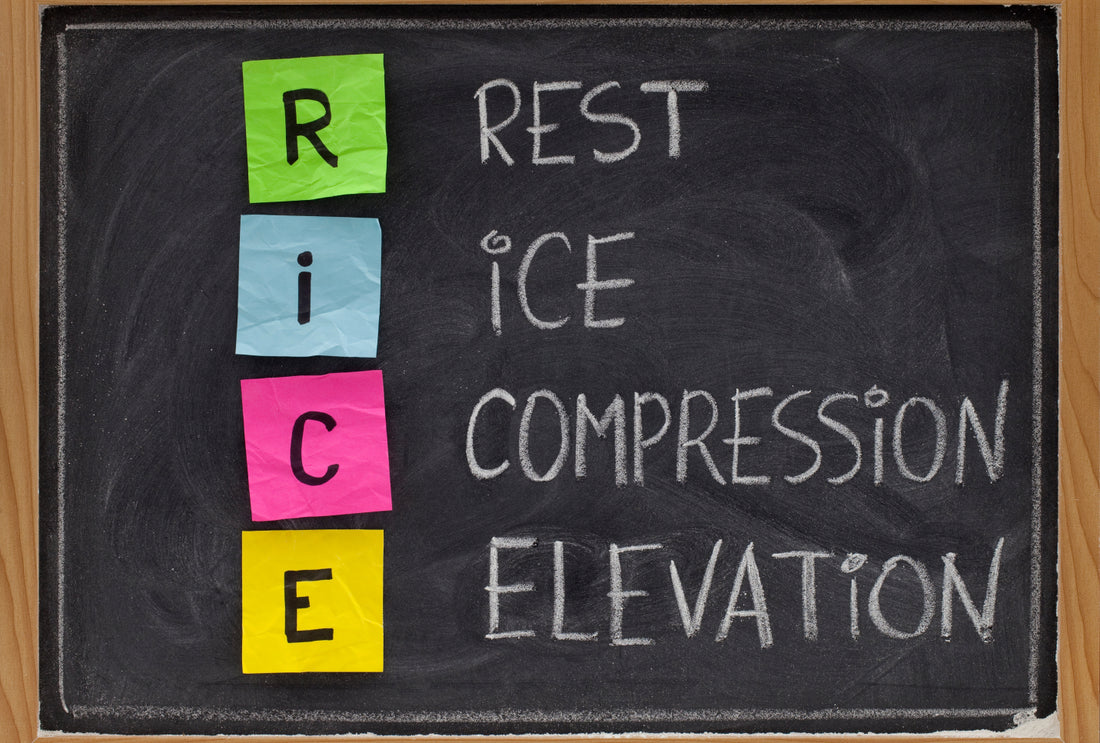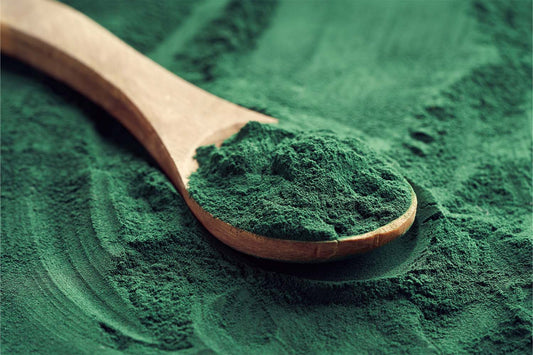We've all found ourselves in this unfortunate scenario at some point. All of a sudden, you find yourself wincing in pain, clutching a muscle — what just happened?
This unexpected turn of events can be daunting, especially when you're unsure of how to proceed. So, what is the RICE method, and how can it help your muscles heal? Let’s dive in.
What Is the RICE Method?
The RICE method (an acronym that stands for rest, ice, compression, and elevation) is a universally recognized protocol for managing most sports injuries, specifically soft tissue injuries. But did you ever wonder how this simple yet effective method came into being?
The origins of the RICE method trace back to the late 1970s. Dr. Gabe Mirkin, a sports medicine specialist and fitness enthusiast, first coined the term in his book published in 1978. This method soon gained popularity and became a mainstay in the realm of sports injury treatment, thanks to its efficacy and simplicity.
What Does RICE Do?
The central aim of the RICE protocol is to minimize swelling, relieve pain, and set the stage for your body's healing process.
It accomplishes this through the combined power of its four components:
- Rest halts activities that might cause further damage.
- Ice application soothes tension.
- Compression controls swelling.
- Elevation assists the circulatory system in draining fluids from the injury site.
Designed to provide immediate relief from acute injuries, the RICE method serves as a powerful line of defense for an array of physical setbacks you might encounter.
It’s commonly applicable to injuries such as an ankle sprain from a misstep during a basketball match, an overextended elbow from an intense tennis game, or a severely bumped shin from an unfortunate collision with a coffee table.
Does RICE Work?
Over the years, this protocol has proven itself to be an invaluable ally in promoting recovery. Its continued widespread use underscores its significance and effectiveness in the world of sports medicine.
So, whether you're an avid athlete, an occasional gym-goer, or someone simply leading an active lifestyle, understanding and effectively utilizing the RICE method can play a crucial role in your injury management strategy.
What Are the Components of the RICE Method?

There are four key aspects of the RICE method. Let’s take a closer look at each part of the RICE method and why it’s so crucial for the healing process:
Rest
The first stop is diving into the “R” part of RICE – rest.
In a high-paced world that lauds relentless action and constant movement, the concept of rest can seem counterproductive. Yet, during an injury, rest acts as the body's primary defense mechanism and a vital regenerative tool.
Rest is critical, as it ceases any physical exertion that could potentially exacerbate the injury, allowing the body the space it needs to initiate recovery. Think of it as creating an ideal environment for your body to launch its self-repair mechanisms. You're essentially communicating to your body, "I'm pausing strenuous activity so you can focus your energy on healing!"
Moreover, it's important to highlight that rest often necessitates immobilization. This could involve using a splint or a brace to ensure the injured area remains stable, preventing further injury and allowing the healing process to proceed unhindered.
Ice
Have you ever wondered why our instinctive response to an injury is to reach for an ice pack? The reasoning is grounded in our body's physiological reaction to tissue damage.
When an injury takes place, your body instinctively increases blood flow to the affected area. This physiological response is a critical part of the body's healing process, yet it also results in swelling and discomfort.
Introducing an ice pack, or a cold pack, to the injury site effectively helps constrict blood vessels, consequently soothing muscular tension and numbing the area to mitigate the sensation of pain.
Think of ice as your body's natural anesthetic. Its application to the affected area numbs the pain, curbs swelling, and reduces soreness, thus supporting fast and comfortable healing.
The use of ice plays a key role in the initial stages of injury management, easing discomfort while your body kicks off its healing process.
Compression
Compression, the “C” in the RICE method, also plays a key role in injury management and healing.
By tightly wrapping the injured area with an elastic or ACE bandage, we administer gentle, consistent pressure that helps minimize swelling.
This pressure reduces the space available for swelling and helps to remove fluid from the area. However, the emphasis here is on gentle pressure.
The bandage should feel snug and supportive, but you should avoid wrapping it too tightly — this could interrupt or cut off blood circulation, which is counterproductive to the healing process.
Elevation
Finally, we reach the last, but certainly not the least significant component of our injury management approach – elevation, the “E” in RICE.
Elevation involves raising the injured body part above the level of your heart. But why is this step essential? Essentially, elevation works in conjunction with the body's circulatory system, assisting in the efficient movement of fluids.
Physically raising the injured tissue encourages the flow of excess fluid away from the site of injury, aided by the natural force of gravity. This tactic is particularly beneficial in managing weight-bearing musculoskeletal injuries like ankle sprains and dislocations.
By reducing the accumulation of fluids and resultant swelling in the affected area, elevation promotes a more conducive environment for healing, ultimately aiding in a quicker and more comfortable recovery process.
How Does the RICE Method Support Recovery from Ankle Sprains?
Let’s look at the applicability of the RICE method in relation to ankle sprains, which are some of the most common injuries.
The intricacy of the ankle, including several ligaments and tendons, often makes recovery from sprains a complex process.
The RICE method offers an accessible and effective way to manage ankle sprains.
Breaking it down:
- Rest gives your ligaments the time off needed to initiate repair, preventing further damage from strain.
- Ice, through its numbing effects, plays a key role in soothing both tension and pain.
- Compression supports the process by easing swelling and supporting internal healing.
- Elevation further aids with recovery, supporting proper fluid drainage and relieving pressure on the affected area.
While the RICE protocol serves as a vital first-aid measure, it's worth remembering that it isn’t necessarily a cure-all.
Depending on the severity of the sprain, your doctor may also recommend nonsteroidal anti-inflammatory drugs (NSAIDs), such as ibuprofen, to manage discomfort and tension.
Furthermore, physical therapy can also help you regain strength and range of motion if recommended by your healthcare provider.
How Can Your Healthcare Provider Help With Sports Injuries?
In the midst of scientific debates and theories (more on those in a minute), there remains one undisputed reality: the integral role of healthcare providers in managing sports injuries. No two injuries are exactly alike.
Healthcare providers, including orthopedic specialists or physical therapists, bring a wealth of expertise to the table. They’re able to evaluate the specifics of each injury case, considering factors like injury severity, patient age, overall health, and personal recovery goals.
Their guidance can vary from advice on the duration of ice applications to correct techniques for applying a compression bandage to the optimal period of rest for a sprained ankle.
Not only that, but these medical professionals can significantly enhance the effectiveness of the RICE method. By tailoring it to individual needs and injury specifics, they ensure the method supports a safe and timely recovery.
Is There Any Controversy or Debate Regarding the RICE Method?
At first glance, the RICE method might seem like an unquestioned staple of sports injury management. However, there is an ongoing dialogue surrounding this approach.
There exists a fascinating debate within the realm of sports medicine regarding the RICE method's overall effectiveness. The controversy centers around whether the application of ice and rest, two fundamental elements of RICE, could potentially delay healing rather than promoting it.
Detractors suggest that because swelling is a natural part of the body's healing process, applying ice to reduce it might interfere with recovery. Likewise, some argue that absolute rest may lead to muscle atrophy, thus extending recovery time.
Evidence exists on both sides of this argument. Several studies suggest that the immediate application of ice following an injury may soothe tension, thereby endorsing the traditional RICE method.
On the other hand, some recent research indicates that icing could slow down the healing process by hindering the body's natural immune response to injury.
Similarly, while complete rest was once considered the best practice, some recent findings advocate for a more active recovery. Gentle movement of the injured area, they argue, might help stimulate blood flow and support healing.
The Bottom Line
The RICE method, despite some controversy, remains an integral part of first-aid for acute sports injuries. It's straightforward, can be performed just about anywhere, and most importantly, it helps manage initial symptoms and kick-starts the healing process.
Whether it's an ankle sprain or pulled muscle, knowing and applying the RICE treatment can make a significant difference.
But remember, the RICE method is just the starting point. For serious injuries, or if symptoms persist, always consult a healthcare provider.
As part of your sports medicine strategy, consider incorporating not just RICE, but a holistic approach to your wellness. For instance, iwi life's plant-based omega-3 supplements could be a great addition to your recovery regimen. These nutrients, derived sustainably from algae, play a key role in maintaining joint health and overall wellness.
So, lace up your sneakers, get on the field, and always remember – in the game of wellness, you're the MVP.
Sources:
RICE (Rest, Ice, Compression, and Elevation) | UK Healthcare
A Doctor Examines the Myths and the Facts of Fitness | The New York Times
Inflammatory Response | London Health Sciences Centre
Acute Ankle Sprain in Athletes: Clinical Aspects and Algorithmic Approach | PMC
NonSteroidal Anti-Inflammatory Drugs (NSAIDs) | Cleveland Clinic
Maintaining Fitness — Not Resting — May Be Key to Recovering From an Injury | The Washington Post



















